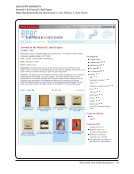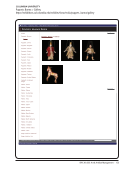SPEC Kit 333: Art &Artifact Management · 35
As with art objects, artifacts are often part of larger archival collections.
Extensive collections of historical photographs, glass plates, etc., primarily from East and West Africa, also postcards,
airline and railroad menus, etc.
Extremely limited in scope—most are textiles.
Largest number of items is numismatics.
Majority of artifacts are historic photographs.
Most are historic photographs and architectural drawings, except for artifacts in the University Archives, which are more
varied.
Most artifacts are related to the history of the institution, with the exception of architectural drawings, designs, and
models (collected as a subject discipline).
Mostly historic photographs.
Number of photographs and historic objects is unclear historic recordings range considerably depending on definition,
but the estimation in the response is based on 100 cylinder recordings.
Our architectural drawings collection is more that 1.5 million items our photography holding across collections are not
fully inventoried but are likely more than 20,000 items.
Over 1/3 of the items are related to numismatics.
Photographs include approximately 13.75 million negatives, transparencies, and prints. Architectural, design, and
engineering drawings are approximately 500,000 items.
Plastics collection is over 10,000 objects historical photographs are in the thousands, as are architectural drawings.
Very broad estimate as neither a large collection of documentary (historic) photos nor the artifacts have yet been
counted.
We have a large collection of historic brass and woodwind instruments.
We have over 6 million photographs. For most items we do not have item level control.
21. Do you routinely separate artifacts from collections of books or archival materials for purposes of
arrangement and description? N=64
Yes 36 56%
No 28 44%
As with art objects, artifacts are often part of larger archival collections.
Extensive collections of historical photographs, glass plates, etc., primarily from East and West Africa, also postcards,
airline and railroad menus, etc.
Extremely limited in scope—most are textiles.
Largest number of items is numismatics.
Majority of artifacts are historic photographs.
Most are historic photographs and architectural drawings, except for artifacts in the University Archives, which are more
varied.
Most artifacts are related to the history of the institution, with the exception of architectural drawings, designs, and
models (collected as a subject discipline).
Mostly historic photographs.
Number of photographs and historic objects is unclear historic recordings range considerably depending on definition,
but the estimation in the response is based on 100 cylinder recordings.
Our architectural drawings collection is more that 1.5 million items our photography holding across collections are not
fully inventoried but are likely more than 20,000 items.
Over 1/3 of the items are related to numismatics.
Photographs include approximately 13.75 million negatives, transparencies, and prints. Architectural, design, and
engineering drawings are approximately 500,000 items.
Plastics collection is over 10,000 objects historical photographs are in the thousands, as are architectural drawings.
Very broad estimate as neither a large collection of documentary (historic) photos nor the artifacts have yet been
counted.
We have a large collection of historic brass and woodwind instruments.
We have over 6 million photographs. For most items we do not have item level control.
21. Do you routinely separate artifacts from collections of books or archival materials for purposes of
arrangement and description? N=64
Yes 36 56%
No 28 44%


















































































































































































